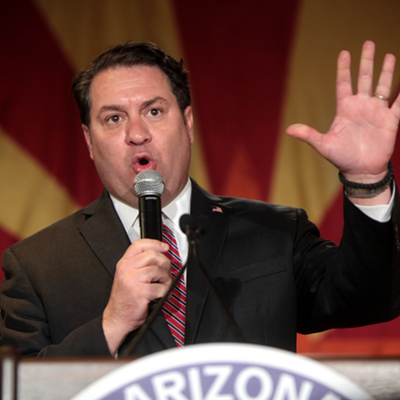But mega-merchandiser Home Depot is pushing ahead with its plan for a 108,000-square-foot store, accompanied by a 24,000-square-foot garden center. The corporation has been sending out misleading mail to local residents asking them to urge the Tucson City Council to allow the mammoth retailer to build more superstores in Tucson -- as if they're about to be barred from doing so.
"The Home Depot hopes to build several new stores in Tucson and to relocate our Broadway/Kolb store to make it more customer friendly," says a letter from the company. "Unfortunately, the Tucson City Council is considering a ban on building new stores like The Home Depot inside the city limits."
Wrong, sawdust-breath.
As Tucson City Councilman Steve Leal said last month, "Our position is that we're not prohibiting big box stores [like Home Depot] per se. What we're doing is prohibiting their impact on local neighborhoods beyond a certain level. These companies are all capable of, and do, make facilities of various sizes."
The issue arose earlier this summer as Home Depot was negotiating with the owners of El Con to plop their "flagship" Tucson outlet on the northeast side of the failing midtown mall property, hard against the lovely El Montevideo Neighborhood.
It's a lousy idea on many levels -- traffic, parking, noise pollution and the fact that the property is in the middle of some of Tucson's most densely populated neighborhoods.
Furthermore, by the time you add up all the paints, pesticides, solvents and other chemicals the store will contain, as well as all that lumber and manure, it makes about as much sense to let the National Guard put an ammunition dump there as well.
In May 1995, a 122,395 square foot Home Depot in Quincy, Mass., caught fire when leaking motor oil from lawn mowers reacted to nearby pool chemicals. The resulting $4 million, four-alarm fire injured 60.
On April 16, 1996, in Albany, Ga., a similar facility caught fire, producing large amounts of irritating smoke and forcing 100 employees and 85 customers to flee. Although the building had what must be considered an adequate sprinkler system, the experts say, it was no match for the rapidly spreading fire, which quickly consumed the 85,000-square-foot building and did an estimated $9 million damage.
Just up the road, in Tempe, a Home Depot caught fire last March 21 when an arsonist apparently used a butane lighter on sale in the store to ignite some seat cushions. The damages, including business losses, were around $6 million. A subsequent report by the National Fire Protection Association (NFPA) drew some frightening conclusions:
· Pesticides and other garden-type chemicals were involved.
· Because of the huge size of the building and the copious amounts of smoke, firefighters had difficulties locating the flames.
· Sprinkler protection in the building "did not match the hazard" presented by the burning merchandise in some areas of the huge store, in one documented instance allowing the fire "to leap across a 10-foot aisle and ignite material stored in that area."
· "Due to the nature of the business, there are very wide and varied commodities being sold in these buildings," the report notes. "Some of these products, such as pesticides, herbicides, oxidizers, flammable and combustible liquids, and aerosols, can present significant hazards. The additional risk of products stored on pallets on the upper shelves dropping during interior fire-fighting operations creates another serious hazard."
Is it any wonder then, with Home Depot apparently insistent about the El Con location, that Leal has also asked city staff to look into beefing up zoning requirements for the "bulk merchandizing store," as the fire guys call such potential hazards. The councilman would like to see Home Depot's zoning changed from mere retail to something more akin to heavy industrial (See "Incendiary Thinking," September 9).
Nobody thinks Home Depot should be redlined out of Tucson. But the men, women and children who live here have a right -- and a duty -- to keep their neighborhoods safe. Their property rights are just as important as a big, powerful corporation's.
If it really cared about its customers rather than its profit margin, as Home Depot's tacky little mailer implies, company officials would drop their El Con plans and look to a much less populated area of town for their next big box.
But we doubt the greedy bastards will do that. So let us be the first to call on the residents surrounding El Con to boycott Home Depot. Don't buy from them, and don't do business with contractors who do, either.
That oughta shake their paint cans a tad.
SPRAWLED OUT: In its post-election analysis, the morning daily, perhaps perturbed that voters once again ignored their endorsement in a Democratic primary, revealed Tucson voters are stupid if they think sprawl is an issue in the city: "--sprawl in Tucson is a county issue, not a city issue. To the extent the election actually was about growth, it was about an issue on which the new mayor will be almost powerless. The valley's high-growth areas are all outside the reach of City of Tucson policies."
Here's a tip for the gang at the Star: The real-estate crowd has been talking a lot about their next playground, the Rincon Valley. While Don Diamond's Rocking K Ranch is out of the city limits, there's a whole bunch of vacant land inside the city's southeastern borders -- and the city is talking about annexing a whole bunch more, which the Star editors would know if they read their own paper. That makes sprawl -- and how the city copes with it -- a vital issue on the horizon.
PRESCOTT DISPATCH: Prescott may have big problems with new growth, but the voters in the state's former territorial capitol have one helluva sense of humor. By a 52 percent margin in a four-way, non-partisan primary election, former congressman, current talk show host, wit and raconteur Sam Steiger was elected mayor.
Steiger, who has lived in Arizona for nearly half a century, ran a unique campaign. He didn't bother to raise campaign funds, for "no big reason other than they made the damn paperwork too hard." Some folks donated some campaign signs that simply said "SAM." (In Prescott, you evidently don't have to ask "Sam who?") And he ran a hardball anti-growth and developer campaign.
Steiger's normal anti-government positions -- he ran as the Libertarian candidate for governor in 1982 -- have many unsophisticated cementheads wondering how you can be an anti-government Libertarian and simultaneously anti-growth. That assumes clear-cutting the desert for more stucco houses (and the fascist homeowner associations that often come with them) is a natural function of the free market. No, gang, the current zoning laws, designed by land speculators and developers years ago to screw over their competition, are part of what caused the problem. Growth can best be controlled by not subsidizing it, a key to Steiger's philosophy -- and his new appeal in Prescott.
With the McKasson victory in Tucson and the voters' rejection of a canal project in Scottsdale, the Growth Lobby is finally discovering just how little the voters really think of it when given anything resembling a viable alternative, from a liberal Democrat like Molly in Tucson to a crusty old right-winger like Steiger in Prescott. Congrats, Sam. Now will the City of Prescott take over the maintenance of that crosswalk?
CADDY SHACK PUTS A PRICE ON THE CADDIES: By a 2-to-1 vote, the Oro Valley Town Council will begin drawing salaries as of next July. Council members will receive $750 per month, while the Mayor will get $950. The vote followed a recommendation from the Town Manager Chuck Sweet.
Mayor Paul Loomis and Councilman Frank LaSala didn't vote, as they would benefit from the raise. Councilman Wayne Bryant voted no, and the measure was passed with the votes of councilman Paul Parisi and Vice-Mayor Dick Johnson. Given that Johnson was appointed to his seat, the whole pay proposal had the support of exactly one official the people of Oro Valley actually elected.
The Council used the usual transparent dodge elected officials grab for when they want more for themselves: they appointed a committee to recommend it. And, aw, shucks, they were just going along with what them nice committee people they picked thought was a good idea.
Johnson piped in with the hoary -- and false -- adage that making the job pay more (the salary replaces the $150 monthly expense stipend) will attract higher-quality candidates. But we're betting it'll attract even bigger losers than you get now: clowns who think $750 a month is big bucks for a part-time job. After all, we've steadily increased the pay of elected officials -- county supes, state legislators, mayors and councils -- but we don't see a big increase in the quality of people seeking those jobs.
WELCOME TO GREEN VALLEY? Stand by for a new incorporation drive in Green Valley. We're told that many of those who opposed prior incorporation efforts are reconsidering after watching Tucson take steps to expand down to Sahuarita's northern border. That means the only way neighboring Sahuarita can expand is south, and most Green Valley folks would rather it didn't.
Then there's the other little element called "self-determination," which becomes considerably more meaningful when other towns are breathing down your neck with potential annexations.
The question: Depending on how the map is drawn, can Green Valley get the permission of Sahuarita or Tucson? There's a chance the purposed new town will be within six miles of one or the other. That means many Green Valley residents should be more than casually interested in the outcome of the lawsuit between Tucson and the new towns of Casas Adobes and Tortolita testing the constitutionality of that six-mile veto power municipalities now have.







